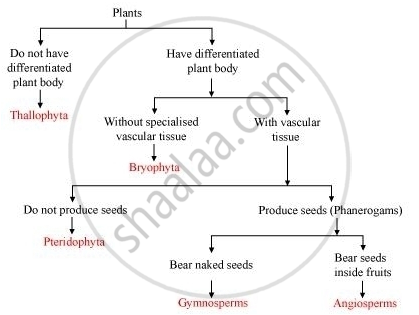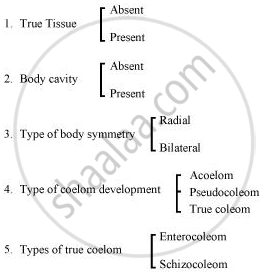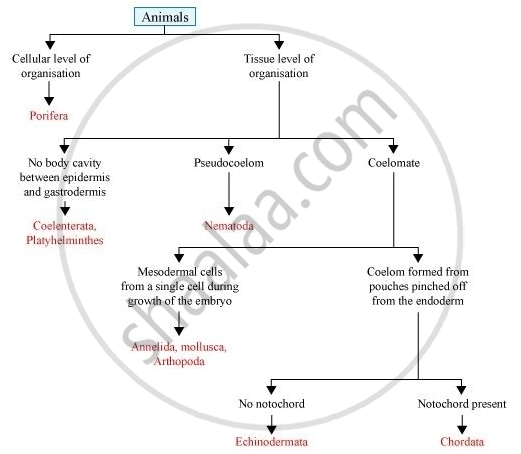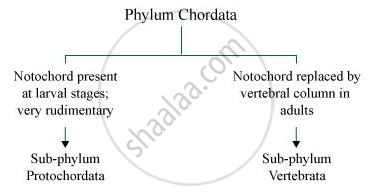Advertisements
Advertisements
Question
How are the criteria for deciding divisions in plants different from the criteria for deciding the subgroups among animals?
Solution
Criteria for deciding divisions in plants are:-
(i) Differentiated/ Undifferentiated plant body
(ii) Presence/ absence of vascular tissues
(iii) With/without seeds
(iv) Naked seeds/ seeds inside fruits

Criteria for deciding subgroups among animals are:-
Kingdom Animalia is divided into two major groups on the basis of the presence or absence of a notochord.

Non-chordates do not possess a notochord, while all members of the phylum chordates possess a notochord.
Non-chordate is further divided into subgroups on the basis of the following features:-

On the basis of the above features, non-chordates are divided into the following subgroups: Porifera, Coelenterate, Platyhelminthes, Nematodes, Annelids, Molluscs, Arthropoda, and Echinodermata.

All members of the phylum chordate possess a notochord. However, some animals such as Balanoglossus, Amphioxus, Herdmania, etc. have a notochord, which is either absent or does not run the entire length of the animal’s body. Therefore, these animals are kept in a separate sub-phylum called Protochordata, and the rest of the chordates are included in the sub-phylum vertebrata. The members of the sub-phylum vertebrata are advanced chordates. They are divided into five classes: Pisces, Amphibian, Reptilia, Aves, and Mammalia.

APPEARS IN
RELATED QUESTIONS
How do poriferan animals differ from coelenterate animals?
Match the animals given under column A with their respective classification group given under column B
| Column A | Column B | ||
| 1 | Sponge | a | Amphibia |
| 2 | Snail | b | Reptilia |
| 3 | Butterfly | c | Echinodermata |
| 4 | Toad | d | Mollusca |
| 5 | Lizard | e | Arthropoda |
| 6 | Starfish | f | Porifera |
Write down four main characters of Annelida.
Write down four characters of Osteichtyes and give two examples.
Write short note on protochordates.
Give an example each of Urochordata and Cephalochordata.
Give one point of difference between notochord and nerve cord.
Explain the general charaters of phylum Mollusca. Give one example of following classes of Mollusca;
(i) Gastropoda;
(ii) Pelecypoda;
(iii) Cephalopoda.
Describe the important characters of mammals and birds. Give two examples of each.
Rewrite the following scientific names correctly.
ficus religiosa (peepal), zea Mays (maize) and Bombyx Mori (silk moth).
Given below is an animal followed by three terms or features. Underline the term which does not match with the animal.
Earthworm - Invertebrata, Annelida, Insecta
Given below is an animal followed by three terms or features. Underline the term which does not match with the animal.
Butterfly- Insecta, Invertebrata, Mollusca
Given below is an animal followed by three terms or features. Underline the term which does not match with the animal.
Bat - Aves, Mammalia, Chordata
Write name of any poikilothermic animal.
Fill in the blanks:
Dog fish belongs to phylum ______.
Choose the correct answer: The animal of phylum protozoa is
Choose the correct answer: Multicellular producers are
Assertion: Binomial name is the universal name and contains two names.
Reason: It was first introduced by Carolus Linnaeus
What is binomial nomenclature?
